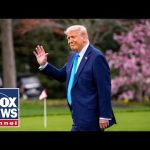President Donald Trump’s recent tariff strategy has reignited debates over America’s trade policies and their broader implications for the economy. In a dramatic move, Trump announced a 90-day suspension of most country-specific tariffs, while simultaneously increasing tariffs on Chinese imports to an unprecedented 125%. This decision underscores his commitment to confronting China’s economic practices but raises questions about its impact on American consumers and businesses.
Trump’s approach reflects his signature “Art of the Deal” philosophy—leveraging tariffs as a negotiation tool rather than a permanent measure. While Wall Street welcomed the temporary pause with a surge in stock prices, the broader economic uncertainty remains palpable. Critics argue that these tariffs, particularly the blanket 10% on all imports, risk inflating costs for everyday goods and disrupting supply chains. However, Trump’s supporters see this as a necessary step to reclaim America’s manufacturing base and reduce dependency on foreign production, especially from adversarial nations like China.
The escalation of tariffs on China highlights Trump’s hardline stance against what he perceives as exploitation of U.S. markets. By raising tariffs to 125%, he aims to force Beijing into fairer trade agreements while protecting American industries from unfair competition. Yet, this move has also drawn criticism for its potential to exacerbate inflation and strain global economic relations. Trump remains undeterred, insisting that the billions generated from these tariffs will strengthen America’s position in trade negotiations.
While some allies have expressed relief over the suspension of reciprocal tariffs, others caution against the unpredictability of Trump’s strategies. European Union leaders have temporarily halted their retaliatory measures, signaling an openness to dialogue but warning of swift counteractions if talks falter. Meanwhile, nations like Canada and Japan continue to navigate the ripple effects of these policies, emphasizing the importance of stable trade partnerships amid growing tensions.
Ultimately, Trump’s bold tariff maneuvers reflect his broader vision of prioritizing American sovereignty and economic strength over globalist pressures. While the path forward remains uncertain, his administration’s willingness to disrupt conventional trade norms signals a shift toward policies that prioritize national interests—even if they come with short-term challenges for markets and consumers. As negotiations unfold over the next 90 days, the nation watches closely to see whether this gamble will yield lasting benefits or deepen economic instability.




